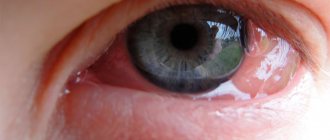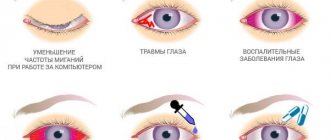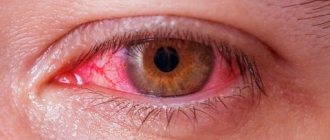When can you become infected?
With the bacterial form, it is easiest to become infected; moreover, treatment takes a very long time, and during this period the person is a carrier of the infection. How many days after infection can you not contact a sick person?
There are several forms of conjunctivitis. Their appearance is associated with the action of various pathogens. Most often, eye inflammation occurs due to an infection, bacteria or allergen.
The viral and bacterial forms are very contagious, unlike the allergic form, they are transmitted by airborne droplets.
Let's consider each type of disease separately.
Is conjunctivitis contagious? Infectious or viral conjunctivitis is spread by airborne droplets, and you can also become infected by sneezing, coughing, direct or indirect contact with a sick person, through dirty hands, objects and personal hygiene products
Since children are the least likely to adhere to precautionary measures, they are therefore more likely to get sick with this form
There are outbreaks of epidemic conjunctivitis. Most often this happens in crowded places where there are sick people.
In addition to the action of viruses, bacteria and pathogens, damage to the mucous membrane of the eyes can be caused by allergens such as pollen, chemicals, as well as colds and hypothermia. If you do not pay attention to the symptoms of conjunctivitis for a long time, you can acquire a chronic form.
https://youtube.com/watch?v=L4InfHucrSc
All information on the site is provided for informational purposes. Before using any recommendations, be sure to consult your doctor. Self-medication can be dangerous to your health.
Almost all conjunctivitis, with the exception of allergic conjunctivitis, is transmitted by contact. Bacteria and viruses from the patient's eyes fall onto the hands, then onto household items and remain there for a long time.
All people who use objects touched by the sick person risk infecting their eyes with this sticky infection. And conjunctivitis especially loves children - after all, they like to walk and touch everything, and then rub their eyes with unwashed hands.
There are several types of conjunctivitis, which can become epidemic. Most often they are caused by various viruses.
Keratoconjunctivitis
One of the factors for its immediate spread is that it is contagious during the incubation period. Symptoms of keratoconjunctivitis are a feeling of debris and cutting pain in the eyes, profuse lacrimation.
The first days of the disease are accompanied by the appearance of follicles and enlargement of the lymph nodes in front of the ears. After a week, pinpoint opacities appear on the cornea, which increases inflammation and photophobia.
It goes away within about a month, sometimes longer (up to 3 months). Corneal opacities may take 1-2 years to resolve.
Hemorrhagic conjunctivitis infection
The causative agent of this conjunctivitis is also one of the viruses that is easily transmitted by contact. It manifests itself acutely - the first symptoms are observed already 1-2 days after infection.
Usually two eyes are affected at once. The peculiarity of this type is multiple hemorrhages: from small dots to extensive spots or stripes.
If left untreated or untreated, hemorrhagic conjunctivitis can become chronic.
Adenoviral form of conjunctivitis
The most common route of infection is contact, but this species can also spread through airborne droplets. It mainly affects small groups of people.
It is easily transmitted among 2-7 year old children, especially in kindergarten and school, where children play with the same toys and use common objects. But you can catch it when visiting a pool, swimming in rivers, ponds or lakes.
It manifests itself acutely - follicles appear, but usually without purulent discharge or clouding of the cornea. With this conjunctivitis, there is an increased temperature, general weakness, and sore throat.
It takes about three weeks.
An eye disease that is caused by viruses or bacteria is called infectious conjunctivitis. How is it transmitted and what are its symptoms? What are the differences between the viral and bacterial variants? We will look at all this below.
If left untreated, infectious conjunctivitis can last for many months, causing discomfort. During treatment, cold compresses are usually used, and the eyes are wiped with a damp cloth.
Do not touch infected eyes with unwashed hands, otherwise treatment may take a long time. You definitely need to contact a specialist.
General signs and treatment of conjunctivitis
Conjunctivitis is a disease that can be quite easily detected in both adults and children, because its first signs are:
- redness and soreness of the eyes;
- profuse lacrimation;
- inflammation of the conjunctiva;
- visual impairment;
- mucous discharge;
- fear of light.
At the first symptoms, you should immediately contact a specialist, especially if you have had contact with an infectious person at work or at home. You cannot self-medicate, as this can lead to complications and cause it to become chronic!
Conjunctivitis should be treated regardless of the type and course of the disease. For this, the ophthalmologist prescribes antibacterial and antiviral drugs. In addition, the infected person is required to:
- Have separate bedding.
- Communicate as little as possible with healthy people and do not kiss children to avoid infecting them.
- Wash your hands constantly.
- Use a personal handkerchief.
- Don't walk in public places.
- Complete treatment.
Although conjunctivitis in children goes away easier and faster, they should not walk outside during illness.
How is the disease transmitted?
| Children can catch conjunctivitis during colds, when the immune system directs all its forces to fight ARVI. |
Microscopic damage to the mucous membrane of the eye increases the risk of developing the disease, since an open door appears for germs, where no one asks for a ticket at the entrance.
Prolonged exposure to the sun without protective equipment is one of the factors that provokes the appearance of eye anomalies.
How is viral conjunctivitis transmitted?
The most dangerous type of disease. If timely treatment is not started, the disease can become chronic or cause serious complications of the visual organ. Viral conjunctivitis is divided into two categories, depending on the type of pathogen:
- Isolated. It is caused by a specific virus, such as shingles or coxsackie,
- Ocular. It is provoked by an infection, for example, influenza, chickenpox, measles, etc.
Patients with such a diagnosis are immediately hospitalized to minimize the risk of contact with healthy people. Initially, unpleasant symptoms appear in one eye, then move on to the second. From the moment of infection until symptoms are detected, three to twelve days pass.
Viral conjunctivitis is usually transmitted by airborne droplets through contact with a carrier of the infection.
Mechanism of transmission of infectious conjunctivitis
The disease develops against the background of overwork or hypothermia of the visual apparatus. The risk group includes people who do not follow hygiene rules or who frequently swim in pools. The acute form of the anomaly can affect the entire family at once, and even large groups (for example, a group in a kindergarten). The causative agents are staphylococcus and streptococcus bacteria.
| The disease also affects newborn babies; they pick up harmful microorganisms as they pass through the birth canal. |
How is the purulent form transmitted?
A widespread form that develops when pyogenic infections penetrate the conjunctival cavities. The main symptoms of the disease: increased tearing of the organ of vision, redness of the eyeball, itching and burning.
You can become infected with the disease at the slightest contact with a sick person; a firm handshake is enough for the infection to spread to you.
How is the adenoviral type of disease transmitted?
The anomaly is transmitted by airborne droplets. The first signs appear in acute form, before the inflammatory processes reach the organ of vision, the upper respiratory tract is affected, body temperature rises, intolerance to bright light appears, redness and swelling of the eyelids are observed.
Treatment of purulent conjunctivitis in adults
An integrated approach is needed to treat the disease. Antibacterial drugs (Albucid, Ciprofloxan) must be prescribed. Before applying the ointment to the affected eyelid, treat it with Furacilin solution or chamomile decoction.
To get rid of unpleasant symptoms, purchase Visine or Artificial Tear eye drops; they will moisturize the eyelids and prevent them from sticking together. Do not use tight bandages under any circumstances, you will only make your situation worse!
Immunologist Andrey Prodeus will talk about the treatment of conjunctivitis in the video.
https://youtube.com/watch?v=ckN1-Rubzyc
Medication
The main drugs aimed at treating purulent inflammation are Actipol, Albucid, Oftalmoferon. The ointment is placed behind the affected eyelid and left overnight to enhance the antibacterial effect. Treatment is continued until the symptoms of the disease are completely eliminated.
Staphylococci are highly resistant to drugs, so fluoroquinolones (for example, Ofloxacin ointment 0.3%) are used to eliminate conjunctivitis caused by such bacteria. Children should not be given antibacterial drops that contain antibiotics.
How to treat purulent conjunctivitis in adults (the order of therapy should not be violated in any case):
- Every day after waking up, clean your eyes of accumulated pus. A weak solution of potassium permanganate is suitable for these purposes. Soak a swab in it or use a clean syringe without a needle. You need to rinse the affected eye several times during the day when pus appears;
- Every hour (or according to the individual recommendations of the ophthalmologist), instill the drug prescribed by the doctor;
- Before going to bed, place tetracycline ointment in the conjunctival sac.
When the acute stage of the disease has passed, the drops can be instilled six times a day.
ethnoscience
Grandmother's recipes effectively fight purulent conjunctivitis, if it is not advanced.
- Make lotions from chamomile infusion four times a day. To do this, pour a tablespoon of dried flowers into a glass of boiling water and let it brew;
- The most effective and affordable way is lotions made from black or green tea. Brew a weak drink, cool and use for compresses;
- Take fresh dill, wash it well and squeeze out the juice. Then soak gauze or a cotton pad in it and apply it to your eyelids, leave for fifteen minutes. An infusion of greenfinch seeds effectively fights purulent inflammation. To prepare it you will need a glass of boiling water and a teaspoon of dill seeds;
- Rinse your eyes with rosehip decoction. Pour a glass of water over a couple of crushed berries and boil for ten minutes. After the infusion has cooled, it can be used;
- Prepare a mask from raw potatoes. Grate the fruit and combine it with egg white, apply the mixture to the eyelids for fifteen minutes;
- Eye drops can be prepared at home. Combine one part honey with two parts water, mix everything well and bury it. The product is also suitable for compresses; store the composition in the refrigerator;
- Lubricate your eyelids, wash your eyes, prepare lotions and drink - all this can be done with plant juices. Juice made from parsley and carrots in a ratio of 1:3 works well for purulent conjunctivitis. Drink it three times a day, one hundred grams before meals.
| Remember that all traditional medicine recipes can be used only after consultation with the doctor. |
Prevention in children
It is, of course, difficult to completely avoid infecting a child with conjunctivitis. However, it is quite possible to minimize this risk. The most important thing is to teach your child to follow the rules of hygiene. You should wash your hands thoroughly when coming home. Explain to him that he should not rub his eyes with dirty hands. Make sure he only uses his own personal hygiene items. Have conversations about this topic, especially when visiting kindergarten. Keep his things clean. Often viruses and bacteria attack the body with a weak immune system. Monitor your baby's general health. Visit a specialist for advice on using immune boosting products. The most important! Having identified symptoms of inflammation of the mucous membrane, if possible, minimize contact with the child for his safety. Is therapy with folk remedies allowed? Most patients equate traditional and traditional medicine. When choosing folk remedies, various goals can be pursued. Some consider it more effective, others - cheaper. Some specialists accept these methods with approval, combining both types of medicine in a comprehensive manner. It is important to undergo consultation before using folk remedies. Consider the examples below. But use them only after consulting a doctor. Home treatment for conjunctivitis involves washing the eyes and relieving swelling. For this, tinctures of the following herbs are used:
- chamomile flowers 1 teaspoon is poured into a glass of boiling water;
- loose leaf tea 1 tablespoon - 2 cups boiling water;
- cornflower flowers 5 inflorescences – 1 glass of water heated to 100C.
You can use these ingredients separately or combine them together. The main thing is to let them cool to room temperature. For a compress, you can use aloe juice, dill juice, and grated potatoes.
Temperature with conjunctivitis
Often eye disease is accompanied by an increase in body temperature. According to experts, this is a normal reaction of the body to a foreign pathogen. Thus, he begins to fight the disease. The immune system activates the production of interferon, which should stop the development of inflammatory processes.
Before lowering the temperature, it is necessary to determine the form of conjunctivitis. Antipyretic drugs can be given if the body temperature has not reached 38 degrees and the child experiences convulsions. You can also give a tablet if the temperature is above 38 degrees and your general condition is poor.
You should not wrap your child in warm blankets or put a lot of clothes on him. It is necessary to maintain the baby’s psychological state in a normal manner. To do this, you need to have fun and play with the child in every possible way so that he does not cry. You need to give him as many warm drinks as possible in the form of teas and herbal infusions.
How to avoid getting conjunctivitis?
The rate of infection depends on several factors:
- General well-being of a person. The stronger his immune system, the higher the body’s defense and, accordingly, the lower the chance of contracting the disease;
- Type of pathology;
- Method of infection. As a rule, the first signs appear an hour after infection. It is recommended to visit the clinic on the same day, since the condition may worsen within a day.
| The main rule for those who do not want to experience all the delights of treating conjunctivitis is to never touch your eyes with dirty hands! |
Is conjunctivitis contagious?
The degree of risk of transmission of conjunctivitis to a healthy person depends on the cause that caused the development of inflammation of the protective membrane of the eye.
The viral type is considered the most contagious disease ; the susceptibility to the bacterial type is lower.
There are forms of conjunctivitis that are not transmitted to others.
Considering the enormous speed at which microorganisms spread, a person with conjunctivitis can only be considered contagious or not after a diagnostic examination and identification of the exact cause of the disease.
Prevention of inflammation of the conjunctival membrane of the eye
If infectious conjunctivitis is transmitted from a patient to a healthy person, then preventive measures must be taken to exclude infection.
Now we know who causes infectious conjunctivitis, we also know the routes of transmission. Thanks to this, it is possible to formulate rules for the prevention of this disease:
- Maintain personal hygiene;
- Wash vegetables and fruits before eating;
- Do not use other people's items;
- Avoid crowded places during widespread flu outbreaks and take a prophylactic dose of antiviral medications;
- Do not come into physical contact with a person whose conjunctival inflammation is bacterial;
- Drink only purified water specifically intended for drinking;
- Do wet cleaning daily to remove dust from surfaces;
- Ventilate living areas and, if possible, provide access to sunlight.
There are contagious and non-contagious forms of conjunctivitis. Only infection caused by bacteria or viruses can be transmitted. Moreover, you can catch inflammation of the conjunctival membrane even from a person who does not have eye problems, since the same pathogens can cause different diseases. So, from a patient with shingles you can become infected with chickenpox or herpetic conjunctivitis: these diseases are caused by the same virus. Take preventative measures to maintain eye health and sharp vision.
https://youtube.com/watch?v=d7rJ0262_Qw
Time required to treat an allergic form of the disease
The allergic form of the disease is diagnosed in approximately 20% of the population; it is caused by allergen irritants, both external and internal. Sometimes this form of the disease is caused by taking certain medications. The peculiarity is that two eyes are affected at once, the course is not the most severe, but long-lasting. Atopic conjunctivitis is not contagious, but unpleasant, so it should also be treated.
All prescriptions for this form of the disease are made by an ophthalmologist together with an allergist or dermatologist.
It is important to determine exactly what causes the disease, take into account all the accompanying symptoms, the general condition of the patient, and only then determine a treatment regimen. It consists of several stages:
- To begin with, you should exclude any contact with the allergen irritant.
- Then a course of complex therapy is prescribed, including the use of antihistamine eye drops and herbal remedies for oral administration.
- For severe allergic conjunctivitis, corticosteroid drugs are prescribed. They are used only in the most severe cases, when conventional antihistamines have not given the expected result.
The full course of therapy may take up to 10–14 days.
Treatment of conjunctivitis
The first thing you should do if you suspect conjunctivitis in a child is to consult an appropriate specialist.
Only a doctor can accurately determine the type of disease and prescribe effective treatment.
Usually for this disease it is prescribed:
- Instillation of albucide solution into sore eyes. How many times is prescribed by the attending physician.
- Rinse the eyes with furatsilin, possibly with chamomile solution. It is done every two hours with separate cotton pads from the outer corner of the eye to the inner one.
- Use of ointments (tetracycline or erythromycin). The ointment must be placed under the lower eyelid.
- The use of antihistamines for allergic conjunctivitis.
In some situations, grandma’s recipes are effective and help block the development of the disease. The most popular treatment method is the use of black tea compresses. They relieve irritation, the main thing is not to overdo it with the strength of the tea leaves.
In order to correctly treat conjunctivitis, you must first correctly determine which type the baby has.
How to prevent pollen allergies
Hay fever is an allergy to pollen. People may have...
Types of disease
Experts distinguish three main forms of conjunctivitis depending on the source of the inflammatory process: viral, bacterial and allergic. Not only the method of treatment, but also the safety of others depends on correct diagnosis, since infectious forms of the disease are contagious to other people and quickly spread in groups.
Bacterial conjunctivitis
About 30% of cases of conjunctivitis are bacterial in nature and are caused by pathogenic microorganisms entering the mucous membrane of the eyes. The most common causative agents of infection on the organs of vision are:
- staphylococcus (in newborns and infants up to one year - Staphylococcus aureus);
- streptococcus;
- mycoplasma;
- chlamydia;
- Trichomonas.
Conjunctivitis caused by staphylococci
The bacterial form of conjunctivitis does not spread so quickly within a group, but is still contagious, therefore, when cases of the disease are detected, it is necessary to disinfect the room in which the patient was for a long time (school classroom, work office, group in a kindergarten), treat common objects and isolate the infected person.
You can distinguish a bacterial infection from a viral one by its characteristic symptoms. The main difference is the formation of thick yellow pus (with gonorrhea, green discharge may appear). In the morning, dense crusts form on the patient’s eyelids, which are dried purulent contents. They can be easily removed using a cotton swab moistened with boiled water or strong tea.
Pneumococcal conjunctivitis
Other symptoms of bacterial eye damage include general signs:
- itching and burning in the eyes;
- increased temperature (not found in all cases);
- weakness and general malaise;
- lacrimation.
The temperature with bacterial conjunctivitis can rise to 38 degrees, but about half of the cases of the disease occur against the background of normal or slightly elevated (to subfebrile values) body temperature.
Treatment of bacterial conjunctivae
Viral conjunctivitis
In the vast majority of cases, the disease is viral in nature and is caused by various groups of viruses: adenoviruses, enteroviruses, herpes virus, etc. The incubation period ranges from 3 to 12 days. During this period, the person is already infectious to others, but signs of the disease have not yet appeared. It is with the long incubation period that doctors associate the high rate of spread of viral conjunctivitis within groups.
The symptoms of the viral form of the disease differ from the bacterial type, so diagnosis usually does not cause difficulties. Signs of viral conjunctivitis include:
- clear discharge from the eyes;
- painful sensations in bright light;
- a feeling of heaviness and a feeling of “sand” in the eyes;
- redness of the eye sclera and white membranes;
- burning and tingling in the eyes;
- clouding of the cornea of the eye.
Treatment of viral conjunctivae
Allergic conjunctivitis
The allergic type occurs in the patient when interacting with allergens. A similar reaction can occur to cosmetics, lens solutions, and some medications. Cleansers and skin care cosmetics can also cause irritation of the conjunctiva and the development of an inflammatory process. Less commonly, manifestations of allergies on the organs of vision occur when consuming certain products or contact with household dust, pollen and animal hair (systemic allergens).
Treatment of drug-induced conjunctivitis
The main symptoms of allergic conjunctivitis are redness, itching and watery eyes. In some cases, these symptoms may be accompanied by rhinitis: nasal congestion, sneezing and difficulty breathing.
Treatment of this form of the disease involves taking antihistamines and local remedies in the form of ointments and drops to eliminate the symptoms of irritation.
Treatment of spring conjunctivitis
Symptoms
Distinctive symptoms are distinguished for bacterial, viral and allergic diseases. With bacterial, redness of the protein, burning, sensation of a foreign body, flow of pus and tear fluid are observed. The listed signs become most intense during the acute phase 5–7 days after the onset of the disease.
The viral infection is characterized by fever, chills, and sore throat. Against the background of these cold symptoms, you feel itching in the eye and the white of the eye turns red.
The allergic form is accompanied by redness of the white, itching, and burning. In this case, swelling of the eyelids and the entire face occurs.
Purulent conjunctivitis is characteristic of bacterial conjunctivitis.
It is quite difficult to distinguish different types of disease from each other, but you can pay attention to the main symptoms that are inherent in them.
Features of transmission of viral conjunctivitis
70% of patients with conjunctivitis suffer from the viral form of this disease. This prevalence of viral infection is not accidental: there are a lot of pathogens (varieties of the virus), and the routes of infection are so simple that it is impossible to completely eliminate them in society.
There are two types of inflammation of the conjunctiva of a viral nature:
- Isolated conjunctivitis. It develops against the background of viruses localized only on the conjunctival membrane of the eye. The remaining organ systems remain unaffected. The causative agents can be viruses: Coxsackie, herpes zoster, herpes simplex, adenoviruses.
- Conjunctivitis as a complication. It develops when an infection spreads inside the body, initially causing another disease, and then affecting the organs of vision. So, inflammation of the conjunctiva can occur against the background of chickenpox, influenza, rubella, measles or mumps.
Viral conjunctivitis is transmitted by airborne droplets or by direct contact with a patient. Since modern man is always among people, it is difficult to avoid infection: pathogens fly in space in tiny droplets of mucus that enter the air during coughing or sneezing. You can also become infected through contact with an object that a sick person has recently held in their hands (or sneezed near it).
Viruses live in the external environment for a relatively short time: from several hours to several weeks. It depends on many factors. But the most “tenacious” viruses were the Coxsackie viruses. They live in wastewater and persist even after treatment for two years. If you drink this water, you can become infected. This type of transmission of infection is called waterborne.
Features of bacterial formation
Bacterial conjunctivitis is a sign of coccal bacteria. There are several ways how conjunctivitis is transmitted. The most common route of infection is household. Sharing household items with a patient, failure to comply with hygiene rules. The most common way to become infected is by sharing a face towel, bedding, or through airborne droplets.
The bacterial species has another route of transmission. They are infected through blood. The issue of inflammation of the mucous membrane should especially concern pregnant women. The appearance of bacteria causes the birth of a baby infected with conjunctivitis. Treatment of bacterial conjunctivitis is carried out jointly by an ophthalmologist and a therapist. Carefully selected antibiotics are used. The photo will help you see the appearance of the eye after bacterial conjunctivitis has been transmitted. Drops are also used:
- Ciprofloxacin;
- Ofloxacin;
- Lomefloxacin.
Ointments:
- Gentamicin;
- Tetracycline;
- Framycetin.
The most commonly used are Moxifloxacin, Fluoroquinolones, etc.
Specific signs of conjunctivitis
Bacterial inflammation makes itself felt by purulent “tears” of pale yellow and sometimes green color. Pain syndrome develops.
There are also specific signs of the disease
Viral conjunctivitis often accompanies influenza and other lesions of the upper respiratory tract of the same etiology. There is moderate secretion of tear secretion and mucus, hypersensitivity of the eyes to bright lighting, and enlargement of regional lymph nodes. In some cases, follicles or pseudomembranes may form on the inner surface of the eyelids.
Allergic inflammation of the conjunctiva is accompanied by unbearable itching, profuse lacrimation, runny nose and cough, and sometimes atopic eczema.
Allergic conjunctivitis
The manifestations of fungal conjunctivitis depend on the type of pathogen. Actinomycosis causes purulent discharge from the eyes, blastomycosis causes the formation of films of gray or yellow shades, candidiasis causes epithelioid and lymphoid nodules, and aspergillosis causes redness of the mucous membranes and inflammation of the cornea.
Fungal conjunctivitis is provoked by various pathogenic fungi
With conjunctivitis caused by the influence of chemicals, pain occurs when moving the gaze, closing and opening the eyelids.
Main symptoms
It is quite difficult to distinguish what type of disease affects you on your own. Therefore, when identifying the first symptoms, you need to immediately visit a specialist. Inflammation of the mucous membrane is expressed as follows:
- eyelids swell;
- the mucous membrane swells;
- noticeable redness of the eyelids;
- discomfort from light exposure;
- excessive tearing;
- cutting pain in the eyes;
- one gets the impression that a foreign body has entered;
- mucopurulent discharge.
Each type has its own complications. Avoid self-medication; you must immediately contact the ophthalmology department. Complications of improper therapy can cause vision loss.
Types of disease
Depending on the course of inflammation, conjunctivitis can be acute or chronic. By origin, it is infectious or non-infectious in nature. In the absence of infection, the disease manifests itself in the form of an allergy to a certain substance or group of substances; exposure to physical factors (dust particles, foreign objects entering the eyes) is also possible.
Infectious development of the disease is possible due to bacteria, fungi, viruses, and chlamydia. It is most dangerous for others, since it can be transmitted, infecting other people.
Viral
This type of conjunctivitis is quite common and can be transmitted from person to person. It is dangerous because if left untreated it becomes chronic. It is followed by complications that can lead to complete or partial loss of vision.
Viral conjunctivitis manifests itself as:
- redness of the eyes;
- feeling of sand in the eyes;
- profuse lacrimation;
- reactions to bright light;
- inflamed lymph nodes.
Adenoviral conjunctivitis, which is caused not by one, but by a whole group of viruses, is becoming increasingly common. Its manifestations are no different from the viral form, but in the absence of personal hygiene rules, it is transmitted to the other eye, complicating treatment.
The virus infects the eyes against the background of colds: acute respiratory infections or acute respiratory viral infections. Possible mucous discharge, formation of follicles, damage to the cornea and the appearance of thin films on the conjunctiva.
Bacterial
It occurs most often due to the colonization of the conjunctiva by colonies of staphylococci and streptococci. Bacteria can get into the eyes with dust, while swimming in bodies of water, or through contact with other people. It often has the character of an epidemic in preschool institutions.
The signs are classic: a feeling of speck in the eye, redness of the whites, swelling of the eyelids. The characteristic signs of this species include viscous yellow purulent discharge from the eyes. Pus leaks frequently and in the morning the eyes may stick together due to its accumulation on the eyelashes.
Allergic
It develops as a hypersensitivity of the body to a certain substance. Often in parallel there is a rash, swelling, rhinitis and other systemic manifestations of allergies. An allergen can be dust, plant pollen, animal fur, or any chemical compound.
The allergy manifests itself in both eyes and is expressed in the form of swelling of the eyelids, watery eyes, itching and burning. Disappears when an allergen is detected and contact with it is avoided.
Chlamydial
Chlamydia includes microorganisms that can invade and infect a cell. They can be infected sexually, but they are parasitic, affecting not only the genitals, but the entire body as a whole.
Chlamydia, when it gets on the mucous membrane of the eye, behaves extremely restrainedly, without clearly showing its presence. The signs are vague and inconsistent, so the patient seeks help from a doctor at the last moment. The main symptoms are usually mild, but enlarged ear lymph nodes can be easily felt.
Toxic
Develops in acute form after instillation of eye drops. A few hours later, an allergy develops to the drug that got on the conjunctiva. A person has complaints about:
- presence of a foreign body in the eye;
- burning;
- itching
Due to photophobia and lacrimation, the palpebral fissure narrows. The conjunctiva and eyelids become red and rough. A rash of small blisters is observed on the skin of the eyelids. Such a reaction is possible to different drops depending on the individual characteristics of the patient.











